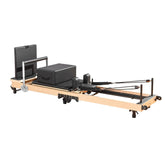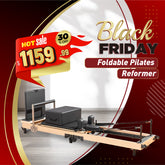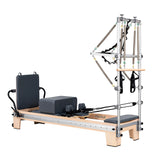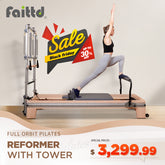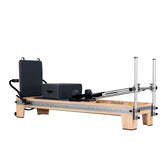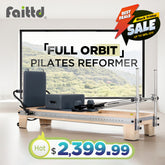What Does Pilates Reformer Do for the Body?
Designed to meet the diverse needs of home practitioners, small studios, rehabilitation specialists, and professional athletes, Pilates Reformer offers a comprehensive solution for physical conditioning, injury recovery, and performance enhancement.
Its unique design supports targeted training for:
- Home practitioners wanting studio-quality workouts
- Small Pilates studios expanding their professional services
- Individuals recovering from cervical spine and waist-related issues
- Core strength development and body plasticity
- Professional athletes undergoing specialized rehabilitation
- Rehabilitation centers seeking versatile training equipment
Whether you're a Pilates studio client seeking to continue your practice at home, an instructor looking to expand your service offerings, or a rehabilitation professional working with athletes, the Pilates Reformer offers a smarter way to move, heal, and grow stronger.
Key Components of the Machine
The Pilates Reformer might look complex at first glance, but its design is both elegant and purposeful. The primary components include:
- Carriage: A padded platform that slides back and forth on rails
- Springs: Adjustable resistance mechanisms that provide varying levels of challenge
- Footbar: An adjustable bar used for pushing and supporting different exercises
- Straps: Attached to pulleys, allowing for upper and lower body movements
- Headrest: Provides support and can be adjusted for different positions

How It Works Mechanically
The genius of the Pilates Reformers lies in its ability to create resistance through its spring system. As you move the carriage, the springs provide varying levels of tension, challenging your muscles throughout the entire range of motion. This constant resistance ensures that muscles are working both during the concentric (shortening) and eccentric (lengthening) phases of movement, maximizing muscle engagement and effectiveness.
Benefits of Using a Pilates Reformer
1. Improves Core Strength and Stability
The Reformer is great in targeting core muscles. Any movement performed on the machine involves deep core engagement that helps in building a strong and stable center. Unlike doing conventional ab workouts, which only tuck into superficial muscles, Reformer Pilates activates deep, stabilizing muscles to create comprehensive core strength that actually translates to better overall body function.
2. Enhances Flexibility and Mobility
Sliding carriage and variable springs permit movements that accomplish gentle stretching and elongation of the muscles. This, in turn, allows for better joint mobility and muscle flexibility than static stretching. These controlled, fluid movements avoid overstretching while simultaneously building strength and increasing range of motion.
3. Builds Lean Muscle and Tones the Body
Reformer Pilates gives an all-around workout that builds long, lean muscles without bulk. Continuous resistance and attention to precise movements help create a well-balanced, toned physique. Employing multiple muscle groups in a single movement while giving attention to proper alignment, the Reformer has the capacity to develop muscles that are highly functional and pleasing to the eye.
4. Supports Posture and Alignment
Poor posture is the hallmark of our modern, sedentary lifestyle. The Reformer by design promotes good body alignment. Each exercise requires thoughtful movement, making one more aware of the positioning of the body. This develops over time into good posture during workouts and in daily living.
5. Aids in Rehabilitation and Injury Prevention
It is great for rehabilitation and preventing injury due to its low-impact nature. Besides being appealing for such adjustments of resistance, its supportive design enables the building up of strength and flexibility within an individual's physical limits safely. Indeed, many physical therapists recommend the use of Reformer Pilates for injury recovery, management of chronic pain, and the prevention of future physical issues.

Pilates Reformer vs. Mat Pilates: 8 Key Differences
Mat Pilates and Reformer Pilates are two prominent methods, each with unique characteristics that cater to different fitness goals and individual needs. While both share the core principles of Pilates developed by Joseph Pilates, their execution and benefits differ significantly.
| Aspect | Mat Pilates | Reformer Pilates |
| Resistance Mechanism | Body weight only | Adjustable spring resistance |
| Equipment Required | Minimal (mat) | Specialized Reformer machine |
| Range of Motion | Limited by floor contact | Expanded through sliding carriage |
| Muscle Engagement | Primarily core-focused | Comprehensive full-body workout |
| Difficulty Progression | Limited | Easily adjustable through spring tension |
| Versatility | Standard movements | Multiple exercise variations |
| Accessibility | Can be done anywhere | Requires specialized equipment |
| Ideal For | Beginners, home workouts | Targeted conditioning, rehabilitation |
Mat Pilates offers simplicity and accessibility, the Reformer provides a more dynamic, comprehensive approach to body conditioning.
Who Can Benefit from Pilates Reformer Workouts?
Unlike most traditional methods of exercise, which so often take on a one-size-fits-all approach, the Reformer offers a unique, individualized experience in fitness, one that honors and caters to the needs and goals of each person.
1. Beginners to Advanced Practitioners
For the beginner, the Pilates machine offers a gentle introduction to fitness with light resistance and fundamental movements. A new practitioner might start with basic leg and arm exercises, using minimal spring tension to build confidence and proper form. The same individual can progress to more complex sequences as skills develop.
Advanced practitioners, on the other hand, transform the Reformer into a professional, challenging workout station. A professional dancer could perform intricate leg extensions and balance challenges on high-tension springs, while an accomplished athlete would incorporate explosive movement patterns that strain both strength and coordination into their work.
2. Athletes and Fitness Enthusiasts
Professional athletes from different disciplines have found unique training potential in the Reformer. While a pro volleyball player would use the machine to enhance shoulder stability and rotational strength, a marathon runner might focus more on core engagement and hip flexibility. Other examples include:
- Swimmers improving shoulder mobility and core strength
- Basketball players enhancing lateral movement and balance
- Runners developing hip flexor strength and preventing common running injuries
- Gymnasts refining body control and muscular precision
What really sets the Reformer apart, however, is its ability to target the stabilizing muscles, which makes it especially helpful for cross-training to build balanced strength and help prevent injuries.
3. Individuals Recovering from Injuries
For individuals recovering from injuries, the Reformer offers a safe, controlled environment to rebuild strength and mobility. Physical therapists often use the supportive design of the machine to help patients recover from:
- Knee surgeries
- Lower back injuries
- Shoulder rehabilitations
- Ankle and foot trauma
- Post-surgical conditioning
The low-impact nature of Reformer exercises allows patients to engage muscles and joints without excessive stress, thus working their way back toward full functionality. Adjustable resistance and professional guidance ensure each movement is both safe and therapeutic.

Transform Your Body with Pilates Reformer
Every session on the Reformer is an opportunity to understand your body's potential. It doesn't matter if you're a fitness beginner or a seasoned athlete—this machine meets you exactly where you are, providing a workout that's simultaneously challenging and supportive. By focusing on controlled, purposeful movements, you'll build strength, improve flexibility, and develop a deeper connection with your physical self.
Frequently Asked Questions About Pilates Reformer
Q1: Is Pilates Reformer suitable for all fitness levels?
Absolutely! The Pilates Reformer is incredibly versatile and can be adapted to suit complete beginners, fitness enthusiasts, athletes, and individuals recovering from injuries. The machine's adjustable springs and resistance allow instructors to modify exercises for individual needs. The certified instructors can then tailor workouts to match your present fitness level, slowly progressing in difficulty as you build strength, flexibility, and confidence. Be it in your 20s or your 70s, a professional athlete, or a starter in the world of fitness—the Reformer will work great for you by being individually adapted for an effective and safe workout.
Q2: How often should I do Reformer Pilates?
For best results, most fitness professionals recommend 2-3 Reformer Pilates sessions a week. Beginners can begin with 1-2 times per week, allowing muscles time to recover and adjust. Because Reformer Pilates is a low-impact workout, you are able to practice more frequently than other high-intensity workouts. If you are incorporating Reformer Pilates into your existing routine, then 2 sessions a week are plenty to supplement your current routine.
Q3: What should I wear to a Reformer class?
Comfort and flexibility are key when dressing for a Reformer Pilates class. Opt for:
- Fitted, stretchy workout clothes that allow full range of motion
- Longer, form-fitting tops that won't ride up during exercises
- Fitted leggings or shorts that prevent fabric from getting caught in the machine
- Grip socks (many studios require these to prevent slipping)
- Avoid loose, baggy clothing that might interfere with machine movements
- Remove any jewelry that could snag on equipment
The goal is to wear clothing that allows your instructor to see your body alignment and movement while keeping you comfortable and secure during the workout.
Q4: Can Reformer Pilates help with weight loss?
While Reformer Pilates isn't primarily a weight loss program, it can significantly contribute to weight management and body composition. The workout:
- Builds lean muscle mass, which increases metabolic rate
- Burns calories through full-body, resistance-based movements
- Improves overall body composition by toning muscles
- Reduces stress, which can help prevent stress-related weight gain
- Enhances body awareness and mindful movement
For effective weight loss, combine Reformer Pilates with a balanced diet and additional cardiovascular exercise. The strength training and muscle-building aspects of Reformer Pilates can be a powerful tool in a comprehensive weight management strategy.
Q5: How is Reformer Pilates different from traditional strength training?
Reformer Pilates stands apart from traditional strength training in several key ways:
- Focus on full-body, integrated movements rather than isolated muscle groups
- Emphasizes proper alignment, posture, and controlled movements
- Uses spring resistance instead of free weights, providing constant tension
- Targets smaller, stabilizing muscles in addition to major muscle groups
- Low-impact approach reduces stress on joints
- Promotes flexibility and mobility alongside strength
- Requires more mental focus and mind-body connection
